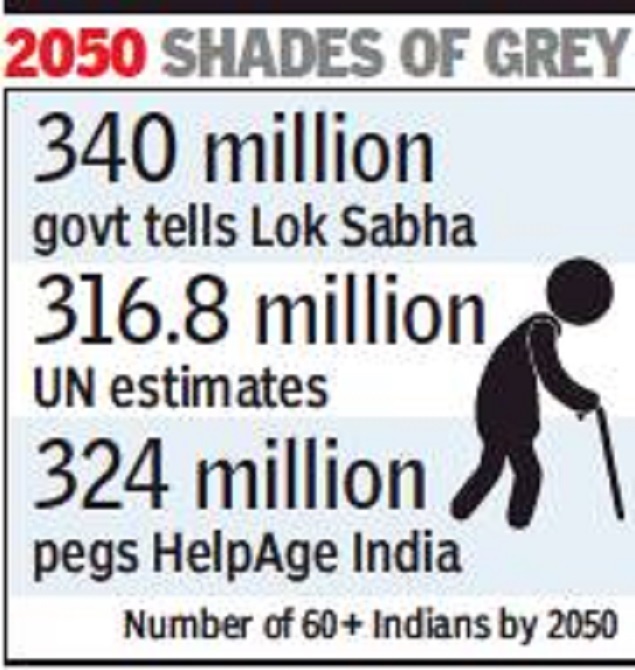Ageing population: India
This is a collection of articles archived for the excellence of their content. |
Population above 60 years of age
8% of population in 2015

From: Sushmi Dey, India ageing faster than earlier projected but not as fast as China, August 13, 2018: The Times of India
India is greying faster than previous projections, even though it fares better than other Saarc countries and China, with the government informing Lok Sabha that the number of elderly aged above 60 will rise to around 340 million by 2050.The number, revealed by minister of state for health Anupriya Patel, is higher than projections made by United Nations and other agencies, which also predict that the elderly population will grow much faster than the overall population with more old “widowed and highly dependent women”.
The UN projected the 60 plus population to grow to 316.8 million by 2050, whereas estimates by HelpAge India pegged the number at 324 million. In either case, the official projection presents a significantly higher number of elderly persons in the population.
Patel told Lok Sabha the growth rate of the 0-14 population is slowing but that of older persons is rising. The age distribution of India’s population is more even as compared to China which has been skewed by the one-child policy resulting in a smaller and declining working age citizenry.
‘India Ageing Report -2017’ by the United Nations Population Fund (UNFPA) says the share of population over the age of 60 could increase from 8% in 2015 to 19% in 2050. By the end of the century, elderly will be 34% of the total population.
During 2000–2050, the overall population of India is expected to grow by 56% while the 60-plus population will increase by 326%. During the same period, the 80-plus population will grow 700% with a predominance of widowed and highly dependent very old women.
While India is expected to report around 19% elderly by 2050, the absolute numbers will be very large. Yet India will be better off than China which is expected to report 34% population above 60 by 2050. Within the Saarc region, Bangladesh (22.4%), Bhutan (24.1%), Maldives (31.2%) and Sri Lanka (27.4%) are estimated to overshoot the Saarc average of 21% by 2050.
According to the UNFPA report, a distinguishing feature in India is a significant interstate disparity. For instance, southern states will have more elderly along with Himachal Pradesh, Maharashtra, Odisha and Punjab. The percentage of 60 plus population in these state varies from 9% to 12.3%, as per census 2011. The central and northern states such as Uttar Pradesh, Rajasthan, Madhya Pradesh, Bihar, Jharkhand, Chhattisgarh and Uttarakhand have much lower proportions of the aged.
Patel said the government is taking steps to ensure care of the elderly with programmes like the national programme for healthcare of elderly that aims to provide dedicated care services. It also includes community-based primary health care approach including domiciliary visits by trained health care workers. Besides, the government plans to start two dedicated national Centres for ageing - each in AIIMS, Delhi and Madras Medical College, Chennai.
Insurance policies need to be more inclusive of elderly care too. “Health insurance penetration among elderly population is very low in India. Insurance companies should have more inclusive offerings with regards to elderly. In fact, Ayushman Bharat scheme is a welcome step towards ensuring elderly care,” says Dr Gaurav Jain, senior consultant- Internal Medicine at Dharamshila Narayana hospital.
"With the increase in population of elderly, several measures including routine health check ups and regular screenings should be done," Dr Manisha Arora, Senior Consultant and Geriatrician at Sri Balaji Action Medical Institute said. Download The Times of India News App for Latest India News.